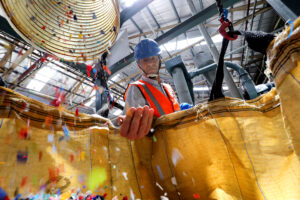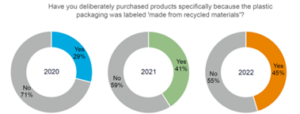
Redefining plastics to achieve true circularity
By NOVA Chemcials Corp.
Canadian Plastics Materials Recycling SustainabilityThere are plenty of opportunities where recycled polyethylene incorporation can be achieved or packages can be redesigned.

Photo Credit: NOVA Chemicals Corp.
From new materials and packaging designs to increased consumer awareness, the shift from a linear to a circular plastics economy has a solid foundation upon which to build through innovation, communication and collaboration across the value chain.
Hurdles remain to ensure plastics are recycled and stay out of the world’s landfills, waterways and other natural environments, and we have a line of sight to solutions for these solvable challenges. Because of all the benefits plastics bring to society, we must not ignore the issue of packaging in the environment but embrace the opportunity to change our mindset to circular models and view today’s waste as a valuable resource. This will keep the plastics industry strong, viable and growing to ship and protect food and other products in an increasingly complex and global supply chain.
Pillars of Sustainability
The attributes that make plastic a material of choice – durability and light weight – provide for plastics to be viewed negatively when not disposed of in an environmentally sound manner. Unlike glass and metal, lightweight plastic floats and becomes a very visible, long-lasting issue. For many people, waste in the environment equals plastic waste.
Industry-backed initiatives, such as the Alliance to End Plastic Waste and the Canadian Plastics Pact, are working to end plastic waste. By thinking of plastic waste as a resource to be used again and again, we also address climate care by providing a low-emission solution for plastic packaging – plastic that has been through the circle more than once. We need to further support this transition at all levels in the value chain by making packaging that truly participates in and enables the plastics circular economy.
At NOVA Chemicals, we’ve set an industry-leading ambition to have recycled content be a 30% share of our total polyethylene (PE) sales by 2030. We also support the North American plastic industry’s commitment to 100% of plastic packaging being recyclable or recoverable by 2030 and 100% being reused, recycled or recovered by 2040.
Achieving our goals and those of the industry rests on three pillars:
- Source reduction and lightweighting;
- Design for recyclability; and
- Post-consumer recycled (PCR) content incorporation.
As an industry, we’ve made substantial progress against the first pillar over the past 20 years. Many rigid formats have been lightweighted, packages have transitioned from rigid to flexible, and flexible packaging has become increasingly thinner while improving performance.
To make the thinner even lighter, we need resins and processes that do the heavy lifting in lightweighting and performance. Both exist today. NOVA Chemicals’ Advanced SCLAIRTECH™ Technology and our SURPASS®, SCLAIR® and ASTUTETM product lines further structure optimization and lightweighting in applications that include food packaging, heavy-duty sacks and rotomolded parts.
Quality In = Quality Out
Whether replacing existing packaging or creating new formats, it’s critical to design for recyclability upfront. Can consumers accept packages with a new aesthetic if they’re recyclable and/or contain recycled content? Perhaps it’s not so glossy, there’s not as much ink or color, or the recycled content can even be seen in the imperfect clarity or gels within the package. To design with recycling in mind, these changes may be required. Letting the aesthetics tell the story of sustainability is a useful approach to engage the consumer.
What is without question is that the quality of a recycling stream’s input must equal the quality of its output to reach true plastics circularity. The preferred way to achieve this is the like-to-like recycling offered by mono-material packaging.
Fortunately, new innovations to replace multi-material packages with mono-material versions are commercially available today. For instance, the industry recently achieved a significant milestone when NOVA Chemicals worked with manufacturers around the world to successfully produce biaxially oriented high-density polyethylene (BOPE-HD) film on commercial tenter frame lines. This PE film enables mono-material package design and is a fully recyclable alternative to traditional non-recyclable, mixed-material films for flexible packaging.
To be successful in mitigating uncertainty and risk when upgrading equipment to handle recyclable packaging, suppliers must prioritize collaboration across the value chain. This includes partnerships between material suppliers, equipment manufacturers, film producers, converters and brand owners to accelerate the development of more sustainable packaging and enable a true circular economy.
An additional layer of collaboration needs to be considered when working with local, state and provincial governments. Being aligned with these entities helps establish increased ownership in transitioning to more recyclable packaging and gives the industry a voice as initiatives like extended producer responsibility (EPR) emerge.
Consumer demand is also an impelling reason to embrace recyclable packaging. According to 2022 NOVA Chemicals consumer research, 51% of respondents ranked “ability to recycle the package” as the first or second most important sustainability feature of packaging. Almost half (45%) had deliberately purchased products specifically because the plastic packaging was labeled “made from recycled materials,” up from 29% in 2020. Consumers aged 44 and under are especially willing to pay for this product attribute.
According to our research, consumers want to be part of the solution and are willing to learn. Their current focus is on recyclability because it’s something they can act on immediately in their households to make a difference. Brand owners can create more opportunities for consumers to be actively involved in the recycling process by designing their packaging for recyclability and communicating with consumers on how to recycle it.

Graph Credit: NOVA Chemicals Corp.
Consumers also must be informed about the changes that may be required in packaging to achieve circularity, such as eliminating windows or moving to a new packaging format. In addition, we need to improve access to recycling and keep it simple for consumers. People lead busy lives, and recycling needs to be easy inside and outside the home.
Infrastructure for Change
In addition to being recyclable, truly circular packaging must contain recycled content. Smart choices in packaging design and improvements to the recycling infrastructure are key enablers to achieving a high-quality and consistently available supply of PCR material.
Mechanically recycled PE has a low carbon footprint and allows package designers and brands to achieve their sustainability goals with today’s recycling infrastructure. Vital to success is having the quality of the recycled content aligned to the end market demand. Food packaging, for example, requires a stream of PCR with the highest level of cleanliness. Improvements in source control, digital watermarks and tracking technology combined with moving to mono-material designs will greatly boost the quality and quantity of like-to-like recycling streams.
At NOVA Chemicals, we’re bringing the right recycled polyethylene (rPE) products to the right markets. With our SYNDIGO™ family of rPE resins, we’re focused on delivering lower-emission, recycled solutions to converters and brand owners that have sustainability goals to achieve.
We have a broad portfolio of rPE grades that are diversely sourced from white PE agricultural film; back-of-store distribution center PE stretch film combined with front-of-store consumer drop off; and natural HDPE milk, juice and water jugs. Through best-in-class material science, quality assurance and product safety expertise, SYNDIGOTM rPE is designed to meet the most demanding performance and safety standards for food contact applications.
Incorporating recycled content into plastic packaging also requires collaboration throughout the value chain – from brand owner demand all the way back to supply. Recycling today is limited by how much plastic waste is being collected. Despite great strides, lack of access to recycling still exists, and flexible films are not widely recycled. More can be done by local governments and the plastics industry to expand consumer access to and engagement in recycling.
Mechanical recycling remains the most efficient and environmentally friendly recycling method for plastics. Its carbon footprint is the lowest of all recycling options and is even favorable to prime PE production. We plan to grow our footprint in mechanical recycling considerably over the next several years to support the industry’s reuse, recycle and recover goals and our own environmental, social and governance goals.
Inroads are also being made in advanced recycling as companies like NOVA Chemicals investigate opportunities to leverage the technology. The ultimate benefit of advanced recycling is that it results in a resin that is indistinguishable from prime. However, we’re still years away from full commercialization and when we can realize the same scale that exists for mechanical recycling today.
A Seat at the Circular Table
Plastic remains a critical material in today’s society because of its light weight and durable features. It has a lower carbon footprint than alternatives like glass and paper and offers a solution that can greatly reduce food waste and enable global supply chains.
Holistically, we must acknowledge the significant concerns about plastics in the environment to gain a full understanding of our challenges when working to increase the adoption of recycled solutions. As we navigate the issues of plastic waste and low recycling rates, we’re learning where we can make the most positive impact. We also believe strongly in listening across the value chain to understand current perceptions and opportunities for change that help the plastics industry achieve a circular economy.
There is no one solution to ending plastic waste. It’s a collective endeavor that requires active and intentional participation. Working together on developing sustainable products, packaging and infrastructure, we can accelerate along the path toward circularity.
The good news is that circular solutions exist within the plastics industry today. At NOVA Chemicals, we offer prime and recycled resins with capabilities to meet virtually any product or packaging need. Our team collaborates with industry partners, customers and brand owners to develop innovative processes and applications that create more opportunities to incorporate circularity into existing operations without compromising quality or performance.
The key is to start now – even a small step forward demonstrates commitment to circularity. Given the multitude of applications that exist for plastics and PE, there are plenty of opportunities where rPE incorporation can be achieved or packages can be redesigned.
Contact our team today. We’ll pull up a chair for you at the circular table.
Reach out to Natalie Clarke for more information – Natalie.clarke@novachem.com
